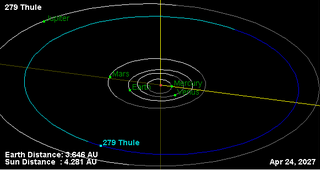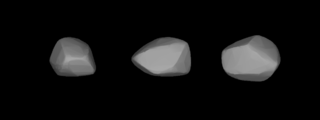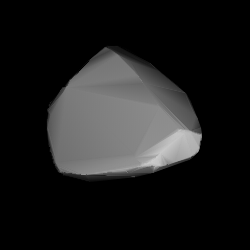
Lumen is a carbonaceous asteroid from the intermediate asteroid belt, approximately 130 kilometers in diameter. It is an identified Eunomian interloper.

Thalia is a large main-belt asteroid. It was discovered by J. R. Hind on December 15, 1852, at the private observatory of W. Bishop, located in Hyde Park, London, England. Bishop named it after Thalia, the Muse of comedy and pastoral poetry in Greek mythology.

Aurora is one of the largest main-belt asteroids. With an albedo of only 0.04, it is darker than soot, and has a primitive composition consisting of carbonaceous material. It was discovered by J. C. Watson on September 6, 1867, in Ann Arbor, and named after Aurora, the Roman goddess of the dawn.

Hekate is a large main-belt asteroid.

Penelope is a large main belt asteroid that was discovered by Austrian astronomer Johann Palisa on August 7, 1879, in Pola. The asteroid is named after Penelope, the wife of Odysseus in Homer's The Odyssey. It is orbiting the Sun at a distance of 2.68 AU with an eccentricity (ovalness) of 0.18 and a period of 4.381 years. The orbital plane is tilted at an angle of 5.8° to the plane of the ecliptic.

Eukrate is a rather large main-belt asteroid. It is dark and probably a primitive carbonaceous body. The asteroid was discovered by Robert Luther on March 14, 1885, in Düsseldorf. It was named after Eucrate, a Nereid in Greek mythology.

Thule, minor planet designation: 279 Thule, is a large asteroid from the outer asteroid belt. It is classified as a D-type asteroid and is probably composed of organic-rich silicates, carbon and anhydrous silicates. Thule was the first asteroid discovered with a semi-major axis greater than 4 AU. It was discovered by Johann Palisa on 25 October 1888 in Vienna and was named after the ultimate northern land of Thule.

Pierretta is a 46 km main-belt asteroid discovered on 28 Aug 1891 by Auguste Charlois at Nice.

Etheridgea is a large main belt asteroid. It was discovered by Auguste Charlois on 1 April 1892 in Nice. The meaning of the name is unknown. This asteroid is orbiting the Sun at a distance of 3.02 AU with a period of 5.26 years and an eccentricity (ovalness) of 0.10. The orbital plane is tilted at an angle of 6.05° to the plane of the ecliptic.

Wilhelmina is a large Main belt asteroid.

Delia is a large Main belt asteroid. It was discovered by the French astronomer Auguste Charlois on 30 November 1894 in Nice. "Delia" is an epithet for the ancient Greco-Roman Moon goddess Artemis, for her birthplace at Delos. This asteroid is orbiting the Sun at a distance of 2.79 AU with an orbital eccentricity (ovalness) of 0.085 and a period of 4.64 yr. The orbital plane is tilted at an angle of 3.35° to the plane of the ecliptic.
Patientia is approximately the 15th-largest asteroid in the asteroid belt with a diameter of 225 km. It was discovered by French astronomer Auguste Charlois on 4 December 1899, and assigned a provisional designation 1899 EY.
Dulcinea is an asteroid orbiting in the inner main belt. It was named after Dulcinea, a character from Miguel de Cervantes' novel Don Quixote. This is classified as a stony S-type asteroid and it is the second largest member of the Erigone collisional family.
608 Adolfine is a minor planet, specifically an asteroid orbiting in the asteroid belt.
623 Chimaera is a minor planet, specifically an asteroid orbiting in the asteroid belt.

662 Newtonia is a minor planet, specifically an asteroid orbiting mostly in the asteroid belt.

714 Ulula is a main belt asteroid. It is orbiting the Sun near the 3:1 Kirkwood Gap with a period of 4.04 years and an eccentricity of 0.057. It was discovered by German astronomer J. Helffrich on 18 May 1911 from the Heidelberg Observatory and was named after an order of owls. The asteroid has a mean radius of 20 km and is spinning with a rotation period of seven hours. Its pole of rotation lies just 4–14° away from the plane of the ecliptic. The surface spectrum shows a pyroxene chemistry and is consistent with mesosiderites/HED meteorites.
843 Nicolaia is a main-belt asteroid discovered by Danish astronomer H. Thiele on 30 September 1916. It was a lost asteroid for 65 years before being rediscovered by Astronomisches Rechen-Institut at Heidelberg in 1981. The asteroid is orbiting the Sun with a period of 3.44 years.
935 Clivia belongs to the Flora family of Main Belt asteroids. Its diameter is about 7.9 km and it has an albedo of 0.197 .
6144 Kondojiro (1994 EQ3) is an asteroid discovered on March 14, 1994 by Kin Endate and Kazuro Watanabe at the Kitami Observatory in eastern Hokkaidō, Japan. It is named after Jiro Kondo, a Japanese Egyptologist and professor of archaeology at Waseda University.













